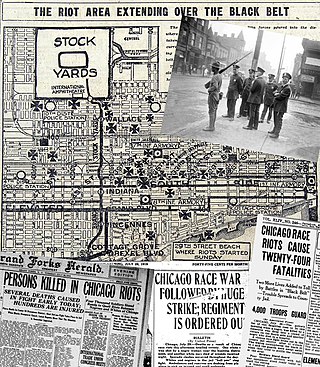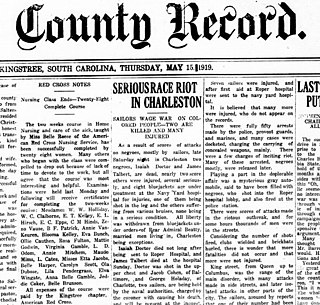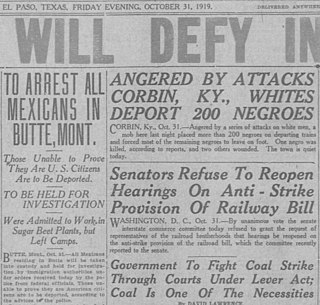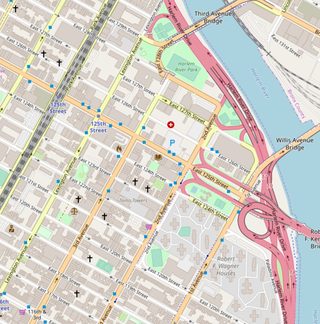
The Red Summer was a period in mid-1919 during which white supremacist terrorism and racial riots occurred in more than three dozen cities across the United States, and in one rural county in Arkansas. The term "Red Summer" was coined by civil rights activist and author James Weldon Johnson, who had been employed as a field secretary by the National Association for the Advancement of Colored People (NAACP) since 1916. In 1919, he organized peaceful protests against the racial violence.

The Chicago race riot of 1919 was a violent racial conflict between white Americans and black Americans that began on the South Side of Chicago, Illinois, on July 27 and ended on August 3, 1919. During the riot, 38 people died. Over the week, injuries attributed to the episodic confrontations stood at 537, two-thirds black and one-third white; and between 1,000 and 2,000 residents, most of them black, lost their homes. Due to its sustained violence and widespread economic impact, it is considered the worst of the scores of riots and civil disturbances across the United States during the "Red Summer" of 1919, so named because of its racial and labor violence. It was also one of the worst riots in the history of Illinois.

The Washington race riot of 1919 was civil unrest in Washington, D.C. from July 19, 1919, to July 24, 1919. Starting July 19, white men, many in the armed forces, responded to the rumored arrest of a black man for the rape of a white woman with four days of mob violence against black individuals and businesses. They rioted, randomly beat black people on the street, and pulled others off streetcars for attacks. When police refused to intervene, the black population fought back. The city closed saloons and theaters to discourage assemblies. Meanwhile, the four white-owned local papers, including the Washington Post, fanned the violence with incendiary headlines and calling in at least one instance for mobilization of a "clean-up" operation.

Berry Washington was a 72-year-old black man who was lynched in Milan, Georgia, in 1919. He was in jail after killing a white man who was attacking two young girls. He was taken from jail and lynched by a mob.

The Charleston riot of 1919 took place on the night of Saturday, May 10, between members of the US Navy and the local black population. They attacked black individuals, businesses, and homes killing six and injuring dozens.

The Baltimore riots of 1919 were a series of riots connected to the Red Summer of 1919. As more and more African-Americans moved from the south to the industrial north they started to move into predominantly white neighborhoods. This change in the racial demographics of urban areas increased racial tension that occasionally boiled over into civil unrest.

The Putnam County, Georgia arson attack was an attack on the black community by white mobs in May of 1919.

The Garfield Park riot of 1919 was a race riot that began in Garfield Park in Indianapolis, Indiana on July 14, 1919. Multiple people, including a seven-year-old girl, were wounded when gunfire broke out.

The Syracuse riot of 1919 was a violent racial attack that occurred when the management of the Globe Malleable Iron Works pitted striking white unionized workers against black strikebreakers in Syracuse, New York on July 31, 1919.

Newman O'Neal was the mayor of Hobson City, Alabama, until he faced death threats and was assaulted forcing him to flee.

Corbin, Kentucky race riot of 1919 was a race riot in 1919 in which a white mob forced nearly all the town's 200 black residents onto a freight train out of town, and a sundown town policy until the late 20th century.

The Wilmington, Delaware race riot of 1919 was a violent racial riot between white and black residents of Wilmington, Delaware on November 13, 1919.

The New York race riots of 1919 developed with increasing racial tension and violent incidents in New York City. These riots were a part of the Red Summer, a series of violent terrorist attacks on black communities in many cities in the United States during the summer and early autumn of 1919. The New York race riots were caused by social tensions such as competition for jobs, politics, and racial tension. Many historians and scholars view these riots as the culmination of racial tensions which had been rising due to the migration of African Americans from the rural South to northern cities. Tensions developed partly due to the competition for jobs, which was worsened by the presence of African American workers who could replace striking White workers.

The Laurens County, Georgia race riot was an attack on the black community by white mobs in August 1919. In the Haynes' report, as summarized in the New York Times, it is called the Ocmulgee, Georgia race riot.

Miles Phifer and Robert Crosky were lynched in Montgomery, Alabama, for allegedly assaulting a white woman.

After young African-American men volunteered to fight against the Central Powers, during World War I, many of them returned home but instead of being rewarded for their military service, they were subjected to discrimination, racism and lynchings by the citizens and the government. Labor shortages in essential industries caused a massive migration of southern African-Americans to northern cities leading to a wide-spread emergency of segregation in the north and the regeneration of the Ku Klux Klan. For many African-American veterans, as well as the majority of the African-Americans in the United States, the times which followed the war were fraught with challenges similar to those they faced overseas. Discrimination and segregation were at the forefront of everyday life, but most prevalent in schools, public revenues, and housing. Although members of different races who had fought in World War I believed that military service was a price which was worth paying in exchange for equal citizenship, this was not the case for African-Americans. The decades which followed World War I included blatant acts of racism and nationally recognized events which conveyed American society's portrayal of African-Americans as 2nd class citizens. Although the United States had just won The Great War in 1918, the national fight for equal rights was just beginning.

Paul Jones was lynched on November 2, 1919, after being accused of attacking a fifty-year-old white woman in Macon, Georgia.

African-American man, Jordan Jameson was lynched on November 11, 1919, in the town square of Magnolia, Columbia County, Arkansas. A large white mob seized Jameson after he allegedly shot the local sheriff. They tied him to a stake and burned him alive.

The lynching of Edward"Red" Roach was the extrajudicial killing of a 25-year-old Black man by a mob of White men in Roxboro, North Carolina, for allegedly assaulting the 13-year-old daughter of popular White tobacco farmer Edward Chambers. Later, Nello Teer, Roach's employer, wrote to The Herald-Sun in Durham decrying the lynching as a “ghastly mistake” because Roach was at work when the alleged attack on Chambers occurred. No one was ever brought to justice for the lynching. A memorial service was held in Durham in remembrance of "Ed" Roach in 2019.

On December 26, 1920, an African-American man named Wade Thomas was lynched in Jonesboro, Arkansas, by a white mob. The mob seized Thomas from the Jonesboro jail after he allegedly shot local Patrolman Elmer Ragland, and murdered him.





















